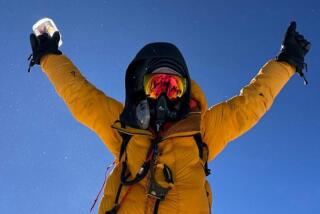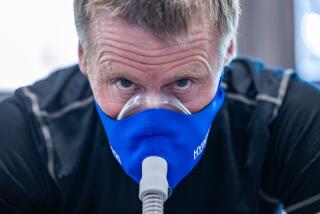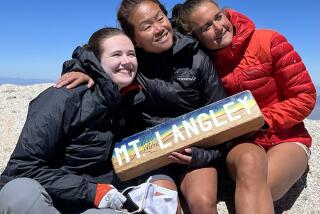Barriers Forgotten on 26-Day Trek : U.S., Soviet Youths Find Accord at Snowy Summit
- Share via
MOSCOW — “It was one of the greatest days of my life--and I will never do it again,” said Taylor Smith, a 20-year-old American who recently climbed to the summit of Mt. Elbrus, an 18,841-foot peak in the Caucasus.
Smith was one of eight Americans who, along with 10 Soviet youths, held their own U.S.-Soviet “summit conference” on the highest mountain in Europe on Aug. 3.
Although they squabbled over food preferences and had to hurdle a language barrier, the Soviets and the Americans came away from their mountaineering adventure as friends.
“When you eat and sleep and hike and shower--and not shower--for days, you lose any false preconceptions you may have had,” Smith said at a news conference Wednesday.
The six-hour ascent of Mt. Elbrus, requiring ice axes and crampons to cross snow-packed fields, climaxed a 26-day trek in remote regions of the Caucasus Mountains.
The climbers started from a base camp at 13,500 feet on the six-mile hike and found they were gasping for breath and ever in danger of altitude sickness.
Both American and Soviet climbers said they relied on each other for psychological support to make it to the top.
When they got there, they planted Soviet and American flags on the peak amid an outpouring of emotion.
“I cried,” said Phil Jones, 17, a Woodland, Calif., high school student. “I was tired, hungry, a little bit sick, but we were working for a common goal.” Smith, a Princeton University student from Jacksonville, Fla., said that it took him two hours to climb the last 500 feet and that he seriously considered giving up several times before he reached the summit.
“I am not an emotional person, but it brought tears to my eyes,” he said.
The Soviet participants were equally moved by their achievement. Alexei Valkov, 19, a student at a communications institute in Moscow, said reaching the top of Elbrus with the Americans will remain in his memory forever.
Token of Friendship
“We completed the climb almost all together,” he said at a news conference. “It showed our cooperation, our friendship. The view of both flags in the wind at the peak impressed me most of all. It was a token of our friendship and cooperation.”
The Americans also planted redwood seedlings, brought from California, in appreciation of the Soviet hospitality.
“It broke the ice,” said Lynne Joiner, a documentary film producer who also made it to the Elbrus summit. “And by the time they had to say goodby, some Americans and Russians did not want to let go of each other.”
But it wasn’t all easy going. Cynthia Lazaroff, executive director of the U.S.-U.S.S.R. Youth Exchange program based in San Francisco, said there were sharp differences over the daily menu.
‘Too Much Sugar’
“Our tastes in food differed considerably,” she said. “Too much sugar or salt or milk or not enough . . . . We learned how to compromise.”
But Horacio Porath, 21, of Sacramento, said the squabbles over food were never entirely Soviet-American disputes.
“Most of our struggle was with ourselves,” he said in an interview. “We were doing extremely difficult things, being cold or hot, sick or fatigued, and that created the problem.”
Other Americans said the language barrier at first was a hardship for both Soviet and American trekkers.
“We overcame it--we were forced to, since we had to depend on each other to survive,” said Troy Shortell, 17, a Solvang, Calif., high school student.
Maureen Eich, 21, of Stockton, Calif., a construction specialist from the California Conservation Corps, suffered a sprained ankle and was not able to make it to the top of Elbrus.
The Soviet participants, she found, were more willing to accept a group decision than the individualistic young Americans.
“The Soviets eat a certain way,” she said. “We had five vegetarians, and some would eat chicken and some would not. Some would drink tea with caffeine and some would not. . . . We had to compromise.”
Karen Bortolazzo, 20, of Benicia, Calif., made it to the top despite fever, headache, lack of sleep and other problems. She credited a Soviet guide-instructor with providing the emotional support she needed.
Lazaroff, the leader of the U.S. team, said she often flagged on the final ascent but got help from Soviet climbers at key moments.
“As two nations, we must keep trying together, and when we stumble, we’ve got to get up and keep going to the top, together,” she concluded.
More to Read
Sign up for Essential California
The most important California stories and recommendations in your inbox every morning.
You may occasionally receive promotional content from the Los Angeles Times.










